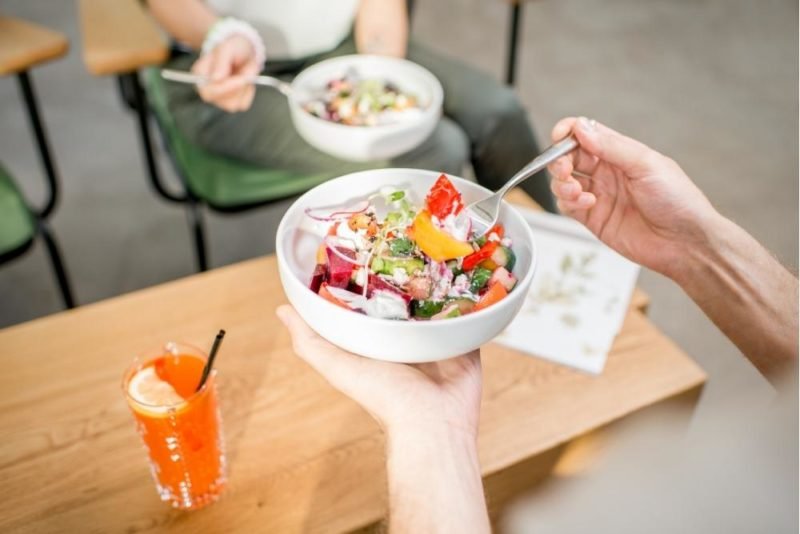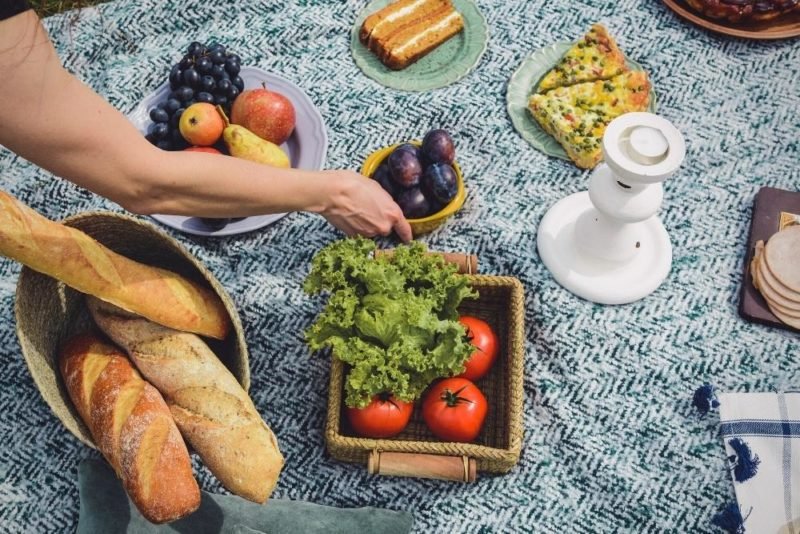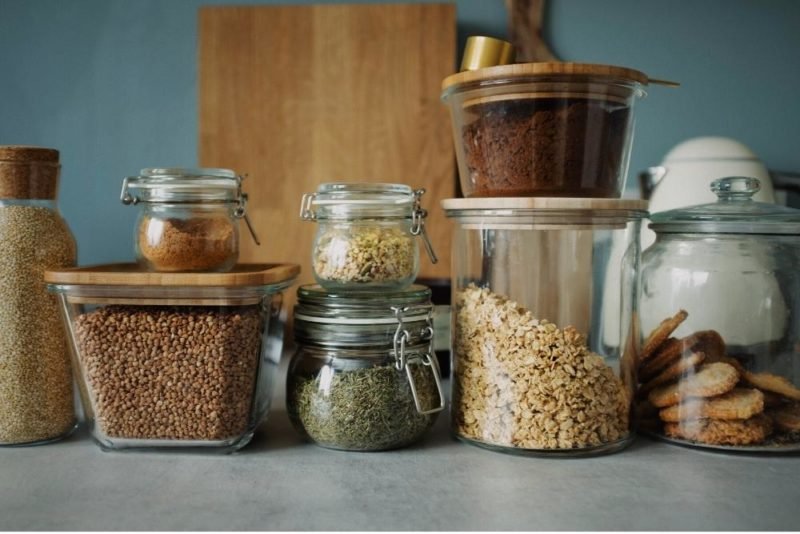
Meal planning can feel like just one more “to-do,” or it can trigger anxiety from past dieting attempts. If you tend to make meal plans, shop for those plans, then watch the food (especially the fresh produce) rot in the fridge while you order takeout, then the very thought of meal planning can become a guilt fest. Those are the negatives.
On the positive side, meal planning can help you meaningfully connect with your food. Now hear me out. When you have a plan, you can decide what’s for dinner (and maybe breakfast and lunch) when you’re not hungry. That means when you are hungry you can focus on preparing and eating, rather than standing in the grocery store (or in front of your refrigerator) waiting for inspiration to strike.
I’ve had many of my intuitive eating clients tell me they eat more intuitively when they do at least light meal planning, because when they don’t take that step, they tend to:
- Get hungry
- Not want to make an impromptu decision about what to eat
- Get primally hungry as more time elapses
- End up grazing on whatever’s handy in the pantry
- Feel unsatisfied and sometimes physically icky

How planning helps you connect
Part of having a healthy, balanced, pleasurable relationship with food is feeling connected to food. That includes grocery shopping and cooking with some sort of plan (unless you are truly an improvisational cook).
For the most part, planners tend to make more satisfying food, and sometime more interesting food. Why, because when you plan, it’s easier to fit a new recipe into your week, rather than relying on tried-and-true standbys 100% of the time.
Planners (who stick to their plan) also tend to waste less food, because they shop for what they plan to use. Part of being connected to our food can include gratitude that we HAVE food, as well as gratitude for the many souls who grew, processed, transported, stocked and facilitated the sale of the food in our carts and in our kitchens. Minimizing waste is one way of demonstrating that gratitude.

Making planning and shopping easier
I wrote an entire blog post previously on “How does meal planning work with Intuitive Eating?” It’s full of great information, so I won’t repeat that here. But I will talk about the merits of having a pantry to fall back on.
Planning and shopping are easier when you don’t have to buy every little thing you need to make a meal. When you have a strategically stocked pantry (strategically, because it’s not just crammed full of random things you won’t eat before they gather dust), you run to the store less, spend less time at the store when you do go, and have emergency backup ingredients on hand if a new recipe is a bust. Here are some of the staples I recommend:

The essentials
Canned salmon and tuna. Make salmon or tuna salad, throw on a green salad, add to pasta, make salmon cakes. Or, my favorite, toss a can of tuna (drained if water-packed, not drained if olive oil-packed) with a can of drained/rinsed white beans and some capers or chopped Kalamata olives. Add a squeeze of lemon, some salt and pepper, and a hearty drizzle of olive oil if your tuna was packed in water. Serve over greens.
Canned beans. Add to a green salad for fiber and protein, blend into a dip, add to soups, combine with grains for a hearty salad, side dish or main dish (rice and beans, anyone).
Nuts and seeds. Pair with fresh or dried fruit for a snack, add to oatmeal or quick breads for a boost of protein and healthy fat, or sprinkle on salads. You can even use chopped walnuts as a plant-based extender (or swap) for meat in tacos or pasta sauces.
Dried and frozen fruit. Frozen fruit is a smoothie staple, but it also works in crisps and cobblers, defrosted and added to oatmeal or overnight oats. Both dried and frozen fruit can be cooked into a compote to top fish, chicken or pork. Dried fruit works as a snack with nuts, or to add additional flavor, fiber and chew to salads or grain dishes.
Pasta and whole grains. Keep your favorite pasta shapes on hand, plus at least a few types of whole grains. Couscous looks like a grain but it’s a tiny pasta, and cooks up in a flash to form a bed for, say, slow-cooked chicken thighs with olives.

The flavor bombs
Condiments. Not just ketchup and mustard! Tahini, soy sauce (or tamari), sesame oil, pesto and curry pastes have infinite uses.
Jarred sauces and salsas. Whether pasta sauce, stirfry sauce, or curry (Indian or Thai) simmer sauces, these can be a perfect vehicle to unite protein and veggies in a tasty way. I keep a few jars of shelf-stable salsa in my pantry in case I run out of the “fresh” versions I prefer from Costo or my grocery store.
Olives and capers. If you love them, they are a flavor life saver. Add capers to a tomato-based pasta sauce, add olives to grain salads or slow-cooked meats, toss in with a sheet pan meal.
Salty cheese. Feta and parmesan liven up salads (both green and grain), pastas and bowls. They also last a long time in the fridge.

A few more thoughts (and caveats)
Even if diet culture hasn’t “ruined” meal planning for you, you might find planning – of any kind – challenging for other reasons. For example, if you are dealing with a chronic health condition or are neurodivergent, you may find planning challenging. But if you also know that you aren’t nourishing yourself as well as you could, you could try doing enough planning to be helpful, but not so much that you run out of spoons.
- Maybe planning what you will take for lunch is most helpful.
- Maybe planning dinners for only part of the week feels do-able.
- Maybe planning dinners for specific nights (when you know making a decision in the moment would be most challenging) feels right.
And, of course, if you find that you are able to put together satisfying, nourishing meals without doing any planning (as with many improvisational cooks), and you find that you can shop for what looks good and manage to uses it all up, then you probably don’t need to meal plan.
I myself am a hybrid. In weeks I’ll have more time to cook, I plan to make a few new recipes, and specifically shop for the ingredients I need. The rest of the time, we decide what to make from our well-stocked fridge/freezer/pantry, and shop just to keep our supplies restocked. We might “plan” when to use the broccoli we just bought, or when to pull chicken breasts out of the freezer, but that’s it.
The “moral” of the story is that there’s no one right way to approach how to decide what’s for dinner. However, if you know that what you’re currently doing isn’t working, and you’re doing a lot of grazing or ordering of takeout, then perhaps more planning will make for more satisfying eating!
Disclaimer: All information provided here is of a general nature and is furnished only for educational purposes. This information is not to be taken as medical or other health advice pertaining to an individual’s specific health or medical condition. You agree that the use of this information is at your own risk.
Hi, I’m Carrie Dennett, MPH, RDN, a weight-inclusive registered dietitian, nutrition therapist and body image counselor. I help adults of all ages, shapes, sizes and genders who want to break free from eating disorders, disordered eating or chronic dieting. If you need to learn how to manage IBS symptoms with food, or improve your nutrition and lifestyle habits to help manage a current health concern or simply support your overall health and well-being, I help people with that, too.
Need 1-on-1 help for your nutrition, eating, or body image concerns? Schedule a free 20-minute Discovery Call to talk about how I can help you and explore if we’re a good fit! I’m in-network with Regence BCBS, FirstChoice Health and Providence Health Plan, and can bill Blue Cross and/or Blue Shield insurances in many states. If I don’t take your insurance, I can help you seek reimbursement on your own. To learn more, explore my insurance and services areas page.
Want exclusive content on nutrition, health, diet culture and more, plus critiques of nutrition and health journalism? Subscribe to my Food Noise newsletter! 📣
 Print This Post
Print This Post






